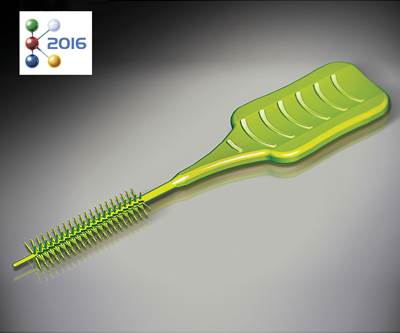K 2016: Connectivity & Collaboration in Robotics & Automation
Besides a handful of new robots and pickers, the big themes were modular ‘plug-and-play’ automation, Industry 4.0 connectivity, easier programming, and safer collaboration with human workers.
As with almost everything else in plastics these days, robots are less and less likely to be considered in isolation, rather than as part of a system, an automated cell, or a networked plant. Hence, much of the emphasis at K was on how robots “play well with others”—i.e., connect with other equipment, and how they can be programmed simply and easily, and also how they can operate safely and “collaboratively” in close proximity with humans.
NEW CARTESIAN ROBOTS & PICKERS
Our previous reporting has covered a new linear robots and servo pickers from Boy Machines, Engel, KraussMaffei, Sepro, and Yushin (August, September, and November Keeping Ups). In addition, Arburg (U.S. office in Rocky Hill, Conn.) brought out a large Multilift V model with 40-kg (88-lb) payload capacity. And Yushin of Japan (Cranston, R.I.) had two new servo models. One is the RCII-150 kick-driven robot for handling large and long parts such as auto bumpers. The unit has a two-axis servo wrist and 40-kg payload. Its telescoping vertical stroke is 1550 mm, kick stroke is 1200 mm, and traverse stroke is 2500 mm. There was also a new version of Yushin’s ultra-high-speed HAS robot with takeout time of only 0.27 sec. Further optimization of the version introduced at K 2013 gave this double-wing model (two robots on one rail) a slimmer profile, less vibration, and 13% lower weight.
After two years of integration and redesign, Wemo Automation of Sweden has combined its lines and those of Hahn in Germany to provide a full range of top-entry and side-entry sizes in a consistent design. These include Xdesign linear robots with payload capacities of 3 to 20 kg (6.6 to 44 lb) for presses of 20 to 800 metric tons; high-speed SDesign linear robots for packaging with up to 3 kg (6.6 lb) capacity for presses of 75 to 300 m.t. The new XLine for large parts has been expanded to include presses from 75 to 2500 m.t. The smaller models are mainly for multi-component machines with vertical injection units. The newest models are the 600 xLine with 60 kg (132 lb) capacity for presses of 1300 to 2500 m.t., and 120 xLine with 12 kg (26.4 lb) capacity for presses of 250 to 500 m.t. Wemo also showed eDesign and iDesign linear robots/pickers with capacities of 2 to 10 kg (4.4 to 22 lb) for presses of 25 to 300 m.t. Wemo is represented here by Robotic Automation Systems, Waunakee, Wisc.
Wittmann Battenfeld (Torrington, Conn.) showcased the new R9 controller for all its robots. Retaining the look and feel of the R8 control, with which it is backwards compatible, the R9 TeachBox pendant has a larger (10.1 in.) screen with higher resolution and a glass covering that accepts multi-touch/gesture commands like a smartphone or tablet, as well as membrane keys for essential inputs. It also is 10% lighter and more comfortable to use.
The R9 control is standard on Wittmann’s new Primus 16 robot for machines from 50 to 200 metric tons. This economical model (an adapted version of the W818) is aimed primarily at Asian molders, but is also available here to molders in areas like Southern California where a small, low-cost, pick-and-place unit is desirable. The Primus 16 has three servo axes and a pneumatic wrist. Payload capacity is 5 kg (11 lb).
CONNECTIVITY FOR INDUSTRY 4.0
Wittmann’s new R9 robot control has the OPC UA (Open Platform Communication Unified Architecture) interface that has been adopted in Europe for machine-to-machine communications under the umbrella concept of Industry 4.0. OPC UA is also part of Wemo’s WIAP 4.0 (Wemo integrated automation process). This includes Wemo connect—a function utilizing a wireless transmitter inside the robot that can communicate with the cloud and with mobile devices. It transmits numbers of cycles, operating hours, cycle times, color-coded operating status, and energy-saving information. Another element is WRS (Wemo Remote Service) for the robot.
At K 2016, Wemo demonstrated WIAP 4.0 through individualized production of laser-printed visitor nameplates with a QR code. A company official said five individualized-production systems have been sold in Europe for electronic, medical, and automotive customers. The first commercial user is producing electrical plugs in several varieties using insert molds. WIAP 4.0 reportedly reduces setup time for multiple short runs of different plugs. Wemo has also received inquiries for such systems from the U.S. and from a Western company operating in India.
OPC UA and Industry 4.0 were also highlighted at the show by makers of six-axis robots. For example, ABB Robotics (Auburn Hills, Mich.) introduced its Connected Services program, which allows for monitoring essential data for predictive maintenance. These include both mechanical and electrical parameters, such as motor temperature, torque, and current draw. Another feature is fleet assessment, whereby users can compare utilization of various ABB robots in their plants.
Kuka Robotics (Shelby Township, Mich.) has added an OPC UA interface to its LBR iiwa (Lightweight Robot intelligent industrial work assistant) collaborative model (see below).
MORE ‘COLLABORATIVE’ ROBOTS
Testimony to the growing interest in so-called “collaborative” robots, which can work safely alongside humans without mechanical guarding, is ABB’s introduction of its first “cobot” entry, called YuMi (see December Starting Up and here). This tabletop, two-armed (each with six axes) unit has a soft, padded covering and no pinch points. Motor torque is low, but the unit is relatively fast for pick-and-place operations. Besides safety, the focus is on ease of use: Simple lead-through programming eliminates the need for an operator screen.
In addition, Fanuc Automation (Rochester Hills, Mich.) showed off a smaller model of its CR six-axis collaborative robots (see Feb. ’16 feature). And Boy Machines (Exton, Pa.) demonstrated direct robot-to-human handoff of glasses of beer, using cobots from Universal Robots of Denmark (E. Setauket, N.Y.).
Meanwhile, several suppliers focused on making conventional robots more collaborative. Sytrama of Italy (New Castle, Del.) and Staubli Robotics of Germany (Duncan, S.C.) demonstrated linear and jointed-arm robots that use compact laser scanners, such as from Sick AG in Germany (U.S. office in Minneapolis), to sense the presence of humans. When a person approaches within a certain distance, the robot continues its cycle, but at a slower speed, which Staubli calls “Safe Limited Speed (SLS).” Coming even closer can cause the robot to stop completely (Safe Operating Stop, or SOS). It starts up again instantly when the person moves away a certain distance. Staubli’s new TX2 six-axis robots also define a Safe Zone around the EOAT to prevent collisions with inanimate obstacles. These models also have a sensor skin; when touched, it brings the robot to a halt. (For more, see December Starting Up and here.)
Kuka also showed off a new way to make standard six-axis robots more like cobots by adding simple lead-through teach programming. This is accomplished via a software upgrade and temporarily connecting a 3D mouse (photo) that communicates via Bluetooth to a tablet. After programming, the mouse can be removed and used somewhere else, while the robot operates normally.
SIX-AXIS & SCARA NEWS
Kuka introduced a new focus on “solutions rather than components” with a series of custom package concepts at various levels of integration. These “Ready2” solutions can include preconfigured software and hardware for specific functions or complete turnkey cells. Kuka works with partners such as robot integrator FPT Robotik GmbH in Germany. Among other things, FPT can program a Kuka robot with a Fanuc-style operator screen for users that are already familiar with Fanuc equipment and software.
In a similar vein, Sytrama now offers its SCP2 control and pendant, standard on its Cartesian robots, for use with six-axis robots from ABB, Kuka, and others. Basic programming is performed with the robot OEM control. Then the SCP2 is connected and runs the robot in a Sytrama environment. The SCP2 can control two robots (linear or six-axis) from one pendant. It can also control upstream and downstream automation.
For high-speed pick-and-place and assembly operations, compact SCARA robots (selective-compliance articulated robot arm) are a well-known option. ABB brought its first SCARA model to K. The new IRB 910SC family is modular with payload capacity of 6 kg (13.2 lb) and “reach” from 450 to 650 mm. Engel has also added a four-axis SCARA model to its line (see August Keeping Up).
MODULAR AUTOMATION PACKAGES
Several suppliers featured “plug-and-play” mobile automation modules that can easily be rolled up beside a press and put quickly to use. Examples previously reported (September Keeping Up) are the Hekuflex system from Hekuma of Germany, the easicell from Engel (York, Pa.), and a similar concept from KraussMaffei (Florence, Ky.).
Also making its debut at the show was a modular LR Mate robot cell from Fanuc, supplied with a Quick Startup software package that includes integration with Fanuc vision systems. And CBW Automation, Fort Collins, Colo., demonstrated its new Advantage Series automation module at the booth of Milacron, Cincinnati. All wired and ready to go, the Advantage series uses a standardized base and frame to reduce costs. Modularity allows the system to be quickly and easily adapted to new parts, minimizing downtime for changeovers. CBW also reduced cost and increased flexibility by replacing high-flow vacuum blowers with a suction-cup retrieval system. Suction cups can easily be relocated to accommodate different parts. Expensive plumbing of vacuum to the EOAT is eliminated.
NEW GRIPPERS
FIPA GmbH of Germany (Cary, N.C.) brought out new 100 series grippers with aluminum jaws fully coated with high-temperature-resistant HNBR rubber. They are said to avoid scratching or marring even painted or plated parts. They contain no silicone. Worn pads can be replaced in minutes.
FIPA also introduced a quick-change system for robot EOAT. It incorporates a snap-on function with a visual locking indication (Safe-Lock).
ASS Maschinenbau GmbH (Plymouth, Mich.) presented three new options for handling warm parts such as preheated organosheet composites. A special heat-resistant gripper, GRZ10-12 HT, has serrated aluminum jaws and withstands long exposure to 150 C (302 F). For dent-free suction holding of warm parts such as organosheets, ASS offers PEEK inserts for its VSE vacuum cups. VS HT+ vacuum cups withstand long-term use at up to 300 C (572 F). The company also has new needle grippers for flexible composite materials.
Related Content
A Cost Saving Modular Approach to Resin Drying Automation
Whether implementing a moisture-sensing closed-loop system for a single dryer, or automating an entire plant, technology is available to take the guesswork and worry out of resin drying. Using a modular approach allows processors to start simple and build more capabilities over time.
Read MoreAI-Based Injection Molding Assistant Launched
LS Mtron’s new AI Molding Assistant and Smart Weight Control technologies can help molders reduce costs while achieving higher quality and productivity.
Read MoreHow Production Monitoring Can Make You a Better Processor
Real-time information on all your production equipment not only boosts productivity and profitability, but it encourages proactive vs. reactive thinking and sharing of best practices. See how this approach benefited a blow molder with 19 plants.
Read MoreAutomation in Thermoforming on the Rise
Equipment suppliers’ latest innovations exemplify this trend driven by factors such as labor shortages, higher-speed thermoformers and tighter quality control.
Read MoreRead Next
ROBOTS TO ‘COBOTS’: Next-Gen Automation in Plastics Processing
So-called ‘collaborative robots’ are a new category of ‘human-friendly’ automation that can work safely side by side with people, unprotected by guarding.
Read MoreINJECTION MOLDING: New Robots & Automation Solutions Coming to K 2016 Show
Look for modular automation systems, new controls, and new robots and pickers.
Read MoreWhy (and What) You Need to Dry
Other than polyolefins, almost every other polymer exhibits some level of polarity and therefore can absorb a certain amount of moisture from the atmosphere. Here’s a look at some of these materials, and what needs to be done to dry them.
Read More


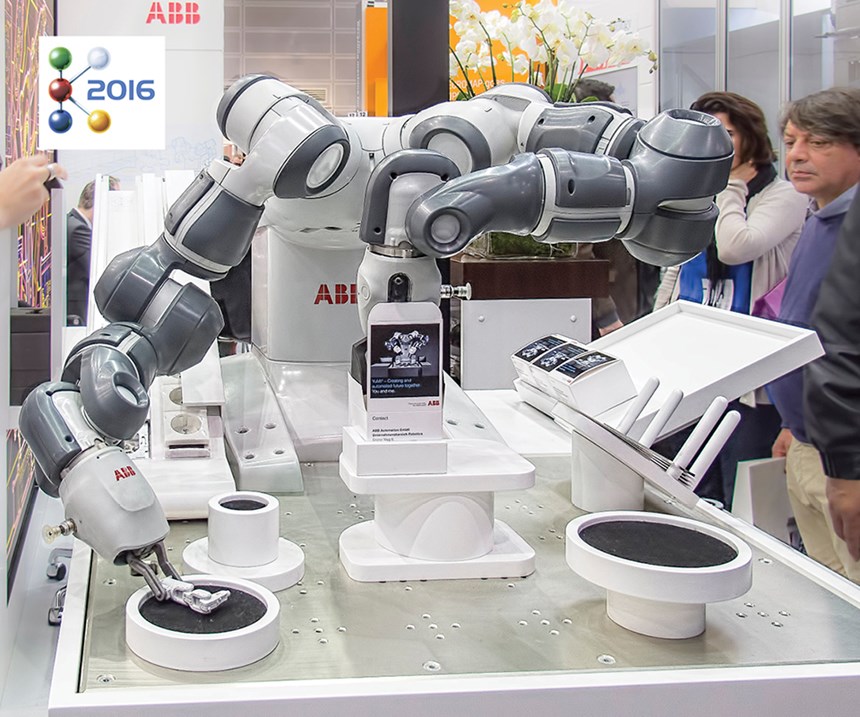
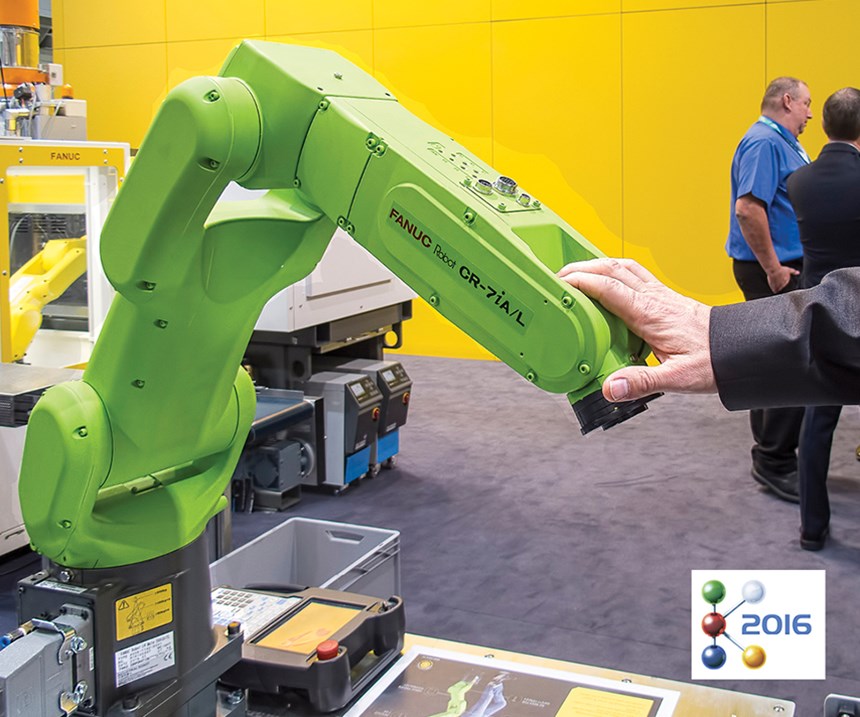
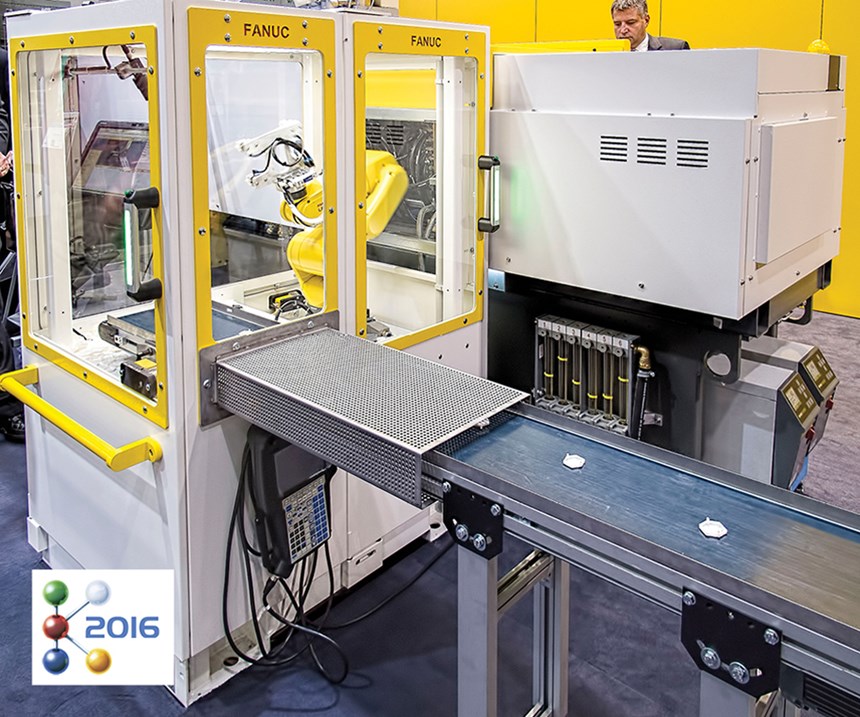


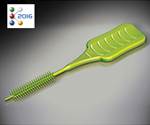







.png;maxWidth=300;quality=90)


















